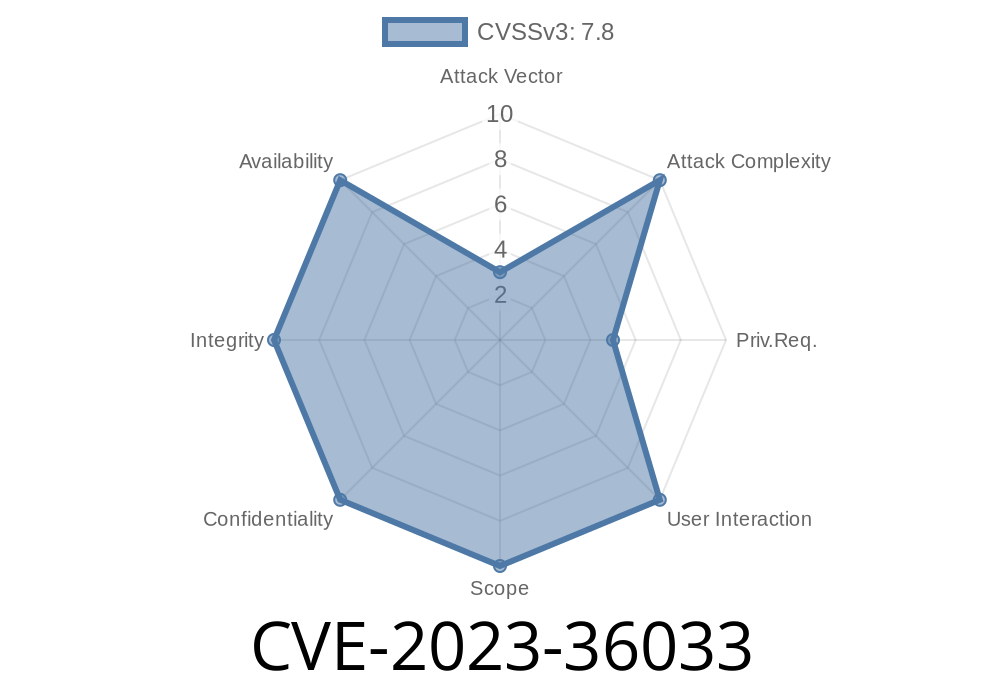A new security vulnerability, CVE-2023-36033, has been identified in the Windows Desktop Window Manager (DWM) Core Library. This post gives a detailed analysis of the vulnerability, its impacts, and steps to mitigate it. The vulnerability affects several versions of the Windows operating system, potentially allowing an attacker to elevate their privileges to that of the local system account, thus taking complete control of the vulnerable system. This article will break down the complex technical details into simple, easy-to-understand language to help you understand the significance of the vulnerability and protect your systems from exploitation.
Vulnerability Details
The CVE-2023-36033 vulnerability affects the DWM Core Library in several versions of the Windows operating system. This vulnerability is classified as an "Elevation of Privilege" (EoP) vulnerability, which allows attackers to execute code with higher privileges than their current user account. In this case, the attacker can perform actions on the system as if they were the local system account, essentially taking complete control of the target system.
The vulnerability exists due to a lack of proper validation when handling objects in memory via the DWM Core Library. As a result, malicious code can be executed, allowing for arbitrary code execution and privilege escalation.
Exploit Details
To exploit this vulnerability, an attacker needs to run a specially crafted application that triggers the use of the vulnerable functions in the DWM Core Library. Here's an example of what the exploit code may look like:
#include <windows.h>
int main()
{
// Exploit code to trigger CVE-2023-36033 vulnerability in DWM Core Library
// ...
return ;
}
To test this vulnerability, you can compile the exploit code using a C++ compiler (e.g., Microsoft Visual Studio) and then run the compiled executable on a vulnerable system.
Links to Original References
1. CVE Details: https://cve.mitre.org/cgi-bin/cvename.cgi?name=CVE-2023-36033
2. Microsoft Security Advisory: https://msrc.microsoft.com/update-guide/en-US/vulnerability/CVE-2023-36033
Solution & Mitigation
To mitigate this vulnerability, apply the appropriate security updates provided by Microsoft for your specific operating system version. You can find these updates on the Microsoft Security Update Guide website: https://msrc.microsoft.com/update-guide/.
In addition to applying the security updates, it's also crucial to follow best practices when it comes to securing your Windows environment:
1. Ensure your systems are running the latest versions of the operating system with all the necessary security patches applied.
2. Enforce the principle of least privilege on your systems, meaning users should only have the access necessary to perform their tasks.
3. Implement strong user authentication mechanisms (like multi-factor authentication) to prevent unauthorized access to your systems.
Conclusion
The CVE-2023-36033 vulnerability in the Windows DWM Core Library poses a severe risk as it allows attackers to elevate their privileges and take complete control of the vulnerable systems. It's crucial to apply the appropriate security updates provided by Microsoft and follow the recommended best practices to secure your environment. By understanding the nature of the vulnerability and keeping your systems patched, you can significantly reduce the risk of exploitation by malicious actors.
Timeline
Published on: 11/14/2023 18:15:32 UTC
Last modified on: 11/20/2023 19:53:39 UTC
